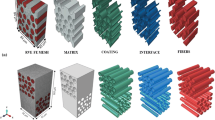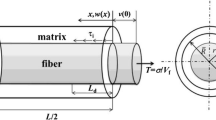Abstract
Crack deflection along the interphase for fiber reinforced ceramic matrix composites (CMCs) is an important condition upon which the toughening mechanisms depend. The multilayer interphase is designed and developed to enhance this deflection mechanism. Combined with the virtual crack closure technique, a finite element model was proposed to predict the competition between crack deflection and penetration in multilayer interphase of CMCs. The model was used to analysis the propagation of primary matrix crack in a SiCf/SiCm composite with (PyC/SiC)n multilayer interphase. The effects of the number of sublayers, thicknesses of sublayers and thermal residual stress (TRS) on the energy release rate and the crack deflection mechanisms were studied. Results show that the multilayer interphase increases the ability to deflect the matrix crack at interfaces between sublayers. Moreover, the number of sublayers shows a larger effect than the thicknesses of the sublayers. The influence of TRS is much complex and needs to be evaluated accordingly. The research provides an analysis tool for promoting the toughening design of CMCs.








Similar content being viewed by others
References
Zhang, D.Y., Meyer, P., Waas, A.M.: An experimentally validated computational model for progressive damage analysis of notched oxide/oxide woven ceramic matrix composites. Compos. Struct. 161(2), 264–274 (2017)
Fagiano, C., Genet, M., Baranger, E., Ladevèze, P.: Computational geometrical and mechanical modeling of woven ceramic composites at the mesoscale. Compos. Struct. 112(6), 146–156 (2014)
Gao, X., Fang, G., Song, Y.: Hysteresis loop model of unidirectional carbon fiber-reinforced ceramic matrix composites under an arbitrary cyclic load. Compos Part B-eng. 56(1), 92–99 (2014)
Yu, G., Gao, X., Fang, G., Xue, J., Song, Y.: Strain field evolution of 2D needled C/SiC composites under tension. J. Eur. Ceram. Soc. 37(2), 531–537 (2017)
Braginsky, M., Przybyla, C.P.: Simulation of crack propagation/deflection in ceramic matrix continuous fiber reinforced composites with weak interphase via the extended finite element method. Compos. Struct. 136(2), 538–545 (2016)
Whitlow, T., Pitz, J., Pierce, J., Hawkins, S., Samuel, A., Kollins, K., Jefferson, G., Jones, E., Vernon, J., Przybyla, C.: Thermal-mechanical behavior of a SiC/SiC CMC subjected to laser heating. Compos. Struct. 210(2), 179–188 (2019)
Ahn, B.K., Curtin, W.A., Parthasarathy, T.A., Dutton, R.E.: Criteria for crack deflection/penetration criteria for fiber-reinforced ceramic matrix composites. Compos. Sci. Technol. 58(11), 1775–1784 (1998)
Li, J., Martin, E., Leguillon, D., Dupin, C.: A finite fracture model for the analysis of multi-cracking in woven ceramic matrix composites. Compos Part B-eng. 139, 75–83 (2018)
Braginsky M, Przybyla C. Crack propagation/deflection in the interphase of sic/sic ceramics matrix continuous fiber reinforced composites. 19th International Conference on Composite Materials, ICCM 2013; July 28, 2013 - August 2; Montreal, QC, Canada: International Committee on Composite Materials; 2013. p. 3705–3713
Naslain, R.: Design, preparation and properties of non-oxide CMCs for application in engines and nuclear reactors: an overview. Compos. Sci. Technol. 64(2), 155–170 (2004)
Schaupert, K.: Effects of fiber coating properties on the crack deflection and penetration in fiber-reinforced ceramic composites. Acta Mater. 45(11), 4721–4731 (1997)
Bertrand, S., Forio, P., Pailler, R., Lamon, J.: Hi-Nicalon/SiC Minicomposites with (Pyrocarbon/SiC)n Nanoscale multilayered interphases. J. Am. Ceram. Soc. 82(9), 2465–2473 (1999)
Yang, W., Araki, H., Noda, T., Park, J.&.;.Y., Katoh, Y., Hinoki, T., Yu, J., Kohyama, A.: Hi-nicalon (TM) fiber-reinforced CVI-SiC matrix composites: I. effects of PyC and PyC-SiC multilayers on the fracture behaviors and flexural properties. Mater. Trans. 43(10), 2568–2573 (2002)
Carrère, N., Martin, E., Lamon, J.: Influence of the interphase and associated interfaces on the deflection of matrix cracks in ceramic matrix composites. Compos Part A-appl S. 31(11), 1179–1190 (2000)
Lacroix, C., Leguillon, D., Martin, E.: The influence of an interphase on the deflection of a matrix crack in a ceramic-matrix composite. Compos. Sci. Technol. 62(4), 519–523 (2002)
Pompidou, S., Lamon, J.: Analysis of crack deviation in ceramic matrix composites and multilayers based on the cook and Gordon mechanism. Compos. Sci. Technol. 67(10), 2052–2060 (2007)
Xie, D., Waas, A., Shahwan, K., et al.: Computation of energy release rates for kinking cracks based on virtual crack closure technique. Computational Methods in Engineering and Science. 6(6), 515–524 (2004)
Xie, D., Waas, A.M., Shahwan, K.W., Schroeder, J.A., Boeman, R.G.: Fracture criterion for kinking cracks in a tri-material adhesively bonded joint under mixed mode loading. Eng. Fract. Mech. 72(16), 2487–2504 (2005)
Liu, P., Yang, Y.: Finite element analysis of the competition between crack deflection and penetration of Fiber-reinforced composites using virtual crack closure technique. Appl. Compos. Mater. 21(5), 759–771 (2014)
Meyer, P., Waas, A.M.: FEM predictions of damage in continous fiber ceramic matrix composites under transverse tension using the crack band method. Acta Mater. 102(1), 292–303 (2016)
Bertrand, S., Pailler, R., Lamon, J.: SiC/SiC minicomposites with nanoscale multilayered fibre coatings. Compos. Sci. Technol. 61(3), 363–367 (2001)
Naslain, R.R., Pailler, R.J.F., Lamon, J.L.: Single- and multilayered interphases in SiC/SiC composites exposed to severe environmental conditions: an overview. Int. J. Appl. Ceram. Technol. 7(3), 263–275 (2010)
Singh S, Singh V, Kumari S, et al. A comparative study of tensile strength of Cf/SiC composites having single layer and multilayer interphases. Ceram Int. 2019;45(17, Part A):21193–21199
Fang, G., Gao, X., Song, Y.: Finite element simulation of stress transfer through the Mul-tilayer interphase in ceramic matrix composites. Acta Materiae Compositae Sinica. 35(12), 3415–3422 (2018)
Fang, G., Gao, X., Song, Y.: Simulation of the crack deflection mechanism for ceramic matrix composites with multilayer interphase. Journal of Aerospace Power. 34(08), 1805–1812 (2019)
Bobet, J.L., Lamon, J.: Thermal residual stresses in ceramic matrix composites—I. Axisymmetrical model and finite element analysis, Acta Metallurgica et Materialia. 43(6), 2241–2253 (1995)
Acknowledgments
This work was supported by the Natural Science Foundation of universities in Anhui Province (KJ2018A0057), the Key Laboratory of Aero-engine Thermal Environment and Structure, Ministry of Industry and Information Technology (CEPE2018006), the National Key Research and Development Program of China (2017YFB0703200), and the National Natural Science Foundation of China (51575261, 51675266, 11972183).
Author information
Authors and Affiliations
Corresponding author
Additional information
Publisher’s Note
Springer Nature remains neutral with regard to jurisdictional claims in published maps and institutional affiliations.
Rights and permissions
About this article
Cite this article
Guangwu, F., Long, L., Xiguang, G. et al. Finite Element Analysis of the Crack Deflection in Fiber Reinforced Ceramic Matrix Composites with Multilayer Interphase Using Virtual Crack Closure Technique. Appl Compos Mater 27, 307–320 (2020). https://doi.org/10.1007/s10443-020-09810-w
Received:
Accepted:
Published:
Issue Date:
DOI: https://doi.org/10.1007/s10443-020-09810-w




